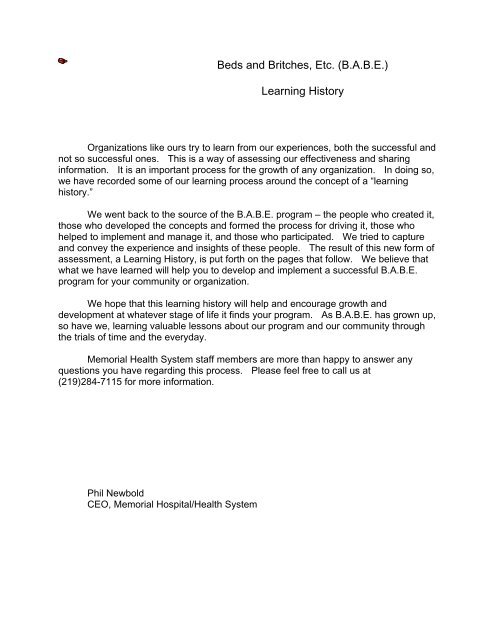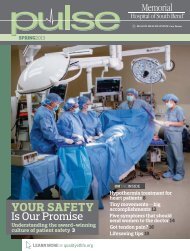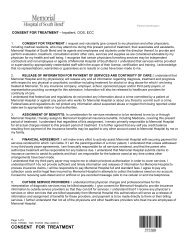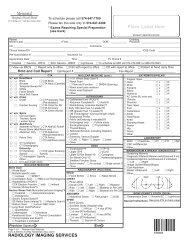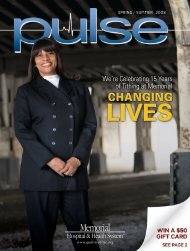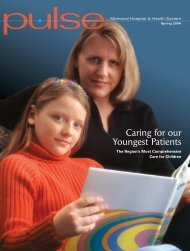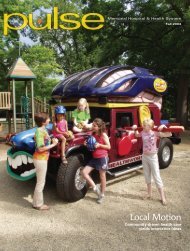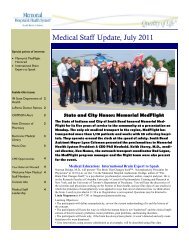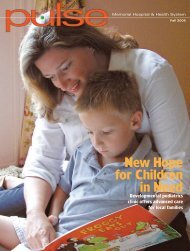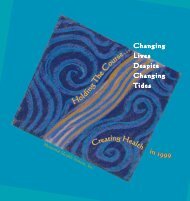Beds and Britches, Etc. (BABE) - Memorial Hospital of South Bend
Beds and Britches, Etc. (BABE) - Memorial Hospital of South Bend
Beds and Britches, Etc. (BABE) - Memorial Hospital of South Bend
Create successful ePaper yourself
Turn your PDF publications into a flip-book with our unique Google optimized e-Paper software.
<strong>Beds</strong> <strong>and</strong> <strong>Britches</strong>, <strong>Etc</strong>. (B.A.B.E.)<br />
Learning History<br />
Organizations like ours try to learn from our experiences, both the successful <strong>and</strong><br />
not so successful ones. This is a way <strong>of</strong> assessing our effectiveness <strong>and</strong> sharing<br />
information. It is an important process for the growth <strong>of</strong> any organization. In doing so,<br />
we have recorded some <strong>of</strong> our learning process around the concept <strong>of</strong> a “learning<br />
history.”<br />
We went back to the source <strong>of</strong> the B.A.B.E. program – the people who created it,<br />
those who developed the concepts <strong>and</strong> formed the process for driving it, those who<br />
helped to implement <strong>and</strong> manage it, <strong>and</strong> those who participated. We tried to capture<br />
<strong>and</strong> convey the experience <strong>and</strong> insights <strong>of</strong> these people. The result <strong>of</strong> this new form <strong>of</strong><br />
assessment, a Learning History, is put forth on the pages that follow. We believe that<br />
what we have learned will help you to develop <strong>and</strong> implement a successful B.A.B.E.<br />
program for your community or organization.<br />
We hope that this learning history will help <strong>and</strong> encourage growth <strong>and</strong><br />
development at whatever stage <strong>of</strong> life it finds your program. As B.A.B.E. has grown up,<br />
so have we, learning valuable lessons about our program <strong>and</strong> our community through<br />
the trials <strong>of</strong> time <strong>and</strong> the everyday.<br />
<strong>Memorial</strong> Health System staff members are more than happy to answer any<br />
questions you have regarding this process. Please feel free to call us at<br />
(219)284-7115 for more information.<br />
Phil Newbold<br />
CEO, <strong>Memorial</strong> <strong>Hospital</strong>/Health System
Infant Stages<br />
<strong>Beds</strong> <strong>and</strong> <strong>Britches</strong>, <strong>Etc</strong>. (B.A.B.E.), a unique “store” <strong>of</strong>fering new <strong>and</strong><br />
used baby clothing <strong>and</strong> equipment, was born from the work <strong>of</strong> a multitude<br />
<strong>of</strong> community members <strong>and</strong> organizations. The story <strong>of</strong> its growth from<br />
a small idea to a living, breathing thing is marked by a collection <strong>of</strong><br />
influences that started work well before the opening <strong>of</strong> the first B.A.B.E. store in 1992.<br />
In 1987 the Healthy Babies project was launched under the auspices <strong>of</strong> <strong>Memorial</strong><br />
Health System, an initiative designed in part to bring a diverse group <strong>of</strong> people together<br />
to work on the issue <strong>of</strong> infant mortality in our community.<br />
In 1989 the St. Joseph County infant mortality rates were 8.5 per 1000 births<br />
overall <strong>and</strong> 20.9 per 1000 births for non-white persons (ISDH). Carl Ellison, Vice<br />
President, Community Affairs at <strong>Memorial</strong> <strong>Hospital</strong> reported that an incentive for the<br />
Healthy Babies project was that infant mortality rates in St. Joseph County exceeded<br />
state <strong>and</strong> national goals. Indeed, in 1990 the infant mortality rate for the state was 9.6<br />
per 1,000 births overall, while in St. Joseph County it was 11 per 1,000 live births (State<br />
<strong>and</strong> Metropolitan Area Data Book.).<br />
Like all community issues, infant mortality reduction was linked to other<br />
complexities. “As we got into the infant mortality reduction area, we found a need to<br />
focus also on those babies that were here,” said Carl. A committee called Healthy<br />
Mothers, Healthy Babies was formed <strong>and</strong> chaired by Julie Koza, Director <strong>of</strong> Healthy<br />
Babies. The committee was a grassroots effort to make a difference in the area <strong>of</strong><br />
maternal <strong>and</strong> child health. In 1991, this committee, made up <strong>of</strong> nurses, social workers,<br />
<strong>and</strong> concerned citizens brought the B.A.B.E. program into the world.<br />
Julie <strong>and</strong> others had investigated programs <strong>and</strong> models that focused on<br />
improving the early lives <strong>of</strong> children through family education <strong>and</strong> support. In the early<br />
nineties a small number <strong>of</strong> committee members, as well as other community leaders -- a
high school principal, social service representatives -- traveled to Rockford, Illinois to<br />
visit a program <strong>and</strong> gather ideas. It was there that they saw the principle <strong>of</strong> what would<br />
later become the B.A.B.E. program in action.<br />
“There happened to be a couple young moms who were there,” Carl said.<br />
They were taking part in a “clothes closet” program where there were “a few<br />
miscellaneous items that the young women...could earn...They testified to how nice it<br />
was to be able to earn things for their baby, <strong>and</strong> you could see the pride, you could see<br />
the self-esteem, associated with that.”<br />
The B.A.B.E. program became a more extensive version <strong>of</strong> this “closet”<br />
idea, always emphasizing family <strong>and</strong> customer self-esteem as the foundation <strong>of</strong> its<br />
mission statement. This principle continues today as a guide in all its development<br />
efforts.<br />
The program works simply. Parents, <strong>and</strong> parents to be, earn B.A.B.E.<br />
coupons by keeping prenatal appointments, attending parenting classes, taking their<br />
child to get immunized, <strong>and</strong> a number <strong>of</strong> other activities that improve family health <strong>and</strong><br />
child development. Physicians, clinics, <strong>and</strong> other social service “vendors” distribute the<br />
coupons to clients who can redeem them at B.A.B.E. stores for merch<strong>and</strong>ise ranging<br />
from baby formula to cribs. The important part <strong>of</strong> this exchange is that customers<br />
come to the store with something they have earned themselves -- coupons -- <strong>and</strong> leave<br />
with something they are able to provide for their child -- a br<strong>and</strong> new stroller, diapers, or<br />
a h<strong>and</strong>made blanket.<br />
“All that work you do when you have a baby,” one B.A.B.E. shopper <strong>and</strong><br />
mother <strong>of</strong> two said, “being able to come here <strong>and</strong> get something you need makes you<br />
feel like you have something to show for it all. I really like it.”
<strong>Beds</strong> <strong>and</strong> <strong>Britches</strong>, <strong>Etc</strong>. (B.A.B.E.) Mission Statement<br />
To provide quality new <strong>and</strong> used children’s clothing <strong>and</strong> equipment...in a manner fostering<br />
responsibility <strong>and</strong> self-esteem. This voluntary committee has no political or religious<br />
affiliation; it is committed to the following goals:<br />
4.<br />
1. To increase awareness <strong>and</strong> utilization <strong>of</strong> maternal, child <strong>and</strong> social services which may assist in<br />
achieving optimum pregnancy outcome <strong>and</strong> well-child health.<br />
2. To promote pride, dignity, <strong>and</strong> self-esteem.<br />
3. To encourage personal responsibility.<br />
4. To leverage community volunteerism <strong>and</strong> support.<br />
First Steps<br />
The Healthy Mothers, Healthy Babies committee soon joined efforts with another local hospital, St.<br />
Joseph <strong>of</strong> Mishawaka, <strong>and</strong> the Women’s Care Center, a pregnancy testing center. The Women’s Care Center<br />
already had a small clothes <strong>and</strong> supply closet to assist families who needed baby items, <strong>and</strong> by collaborating<br />
with the B.A.B.E. program, service duplication was avoided.<br />
“No one wanted to be left out,” described Julie Koza, amazed at the ease with which community partners<br />
appeared on the scene from the onset. The hospitals <strong>and</strong> other agencies involved let their employees donate<br />
time to setting up the B.A.B.E. program. The more community support increased, the more collaborators<br />
expressed their willingness <strong>and</strong> excitement to be involved. “Politics worked in our favor,” Julie said, “Everyone<br />
wanted to make sure it was a community project.”<br />
The first B.A.B.E. store opened in Mishawaka in 1992, using space donated by the Women’s Care
Center. Volunteers had cataloged <strong>and</strong> tagged merch<strong>and</strong>ise based on a “shopping list” <strong>of</strong> baby items that most<br />
families would need or want. Vendors had been recruited well in advance <strong>of</strong> the opening to give them time to<br />
distribute B.A.B.E. coupons to clients, but still, Julie said, “We had no idea how many people would come in.”<br />
B.A.B.E. relies on coupon vendors to control the number <strong>of</strong> shoppers they see. A smooth operation is<br />
dependent on a reasonable number <strong>of</strong> people redeeming their coupons over time. “When we opened, we<br />
didn’t know how many coupons were out there floating around.”<br />
Figuring out coupon numbers <strong>and</strong> distribution, shopper flow, stocking, <strong>and</strong> inventory, was a gradual<br />
process shaped by customer visits <strong>and</strong> requests that first year. In the very beginning, however, much <strong>of</strong> it was<br />
luck. Julie says they were clear with partners <strong>and</strong> the community from the beginning that glitches might arise<br />
that would have to be worked out together -- running out <strong>of</strong> baby items, having more coupons presented than<br />
they were able to redeem, or even little or no customer interest in the store. “But everything just fell into place,”<br />
she said.<br />
Growth Spurts<br />
In its second year, B.A.B.E. grew by ten percent, “selling” 3,877 items. The third year,<br />
B.A.B.E. experienced a 43% increase in the number <strong>of</strong> people served. Saint Joseph’s Regional<br />
Medical Center sponsored a second store in 1993, which opened in <strong>South</strong> <strong>Bend</strong>. Based on the partnership<br />
already formed between the organization <strong>and</strong> B.A.B.E., this store also operated out <strong>of</strong> a Women’s Care Center.<br />
In March <strong>of</strong> this same year, <strong>Memorial</strong> <strong>Hospital</strong> granted funds for a part-time coordinator <strong>and</strong><br />
administrative support, eventually adding a full-time program assistant in 1996. Other funding came from<br />
private donations, service clubs, foundations <strong>and</strong> fundraising.<br />
By the time a third store opened in <strong>South</strong> <strong>Bend</strong> in April <strong>of</strong> 1997, over 85 doctors, clinics, <strong>and</strong> social<br />
service agencies served as B.A.B.E. coupon vendors. Not only had new stores appeared, but more <strong>and</strong> more<br />
segments <strong>of</strong> the community were a part <strong>of</strong> the B.A.B.E. program, distributing coupons <strong>and</strong> using the B.A.B.E.<br />
stores as incentives for their clients. “One <strong>of</strong> the biggest successes I thought,” said Julie, “was that WIC
east-feeding classes became full when people found out they could get [B.A.B.E.] coupons.”<br />
Indeed, attendance at nutrition <strong>and</strong> breast-feeding classes sponsored by WIC increased by fifty percent,<br />
Patti Meuninck, WIC Clinic Nutrition Supervisor in Mishawaka, verified. “I was here when the program started,”<br />
Patti said, “It was phenomenal how much word <strong>of</strong> mouth spread…It definitely made a difference.”<br />
In this way, B.A.B.E. supported other community programs, encouraging women <strong>and</strong> families to seek<br />
educational opportunities, decreasing the number <strong>of</strong> doctor <strong>and</strong> clinic appointments missed at <strong>of</strong>fices that<br />
distributed coupons, <strong>and</strong> ultimately contributing to the health <strong>of</strong> children in our community.<br />
In 1998 alone, over 1,600 families made “purchases” at B.A.B.E. <strong>of</strong> St. Joseph County stores, for<br />
a total <strong>of</strong> 7,873 coupons redeemed. Eighty-five coupon distributors continue to participate in the program<br />
today, a number Judy admits may be too many for the most efficient coordination. WIC distributes the largest<br />
number <strong>of</strong> B.A.B.E. coupons <strong>of</strong> these vendors, followed by a family practice, a prenatal clinic, <strong>and</strong> two other<br />
local family health centers.<br />
Our community has not been the only area to benefit from the growth <strong>of</strong> the<br />
B.A.B.E. program. In 1993, with the help <strong>of</strong> the Healthy Mothers, Healthy Babies committee,<br />
Fort Wayne opened A Baby’s Closet (ABC), <strong>and</strong> Evansville soon followed suit. Neighboring<br />
Elkhart County opened their B.A.B.E. store in<br />
December <strong>of</strong> 1994 with strong volunteer support from the Healthy Mothers, Healthy Babies Committee <strong>of</strong> St.<br />
Joseph County. Indianapolis was the first to bring the B.A.B.E. project to an urban setting, opening at least<br />
three stores since June <strong>of</strong> 1996. The establishment <strong>of</strong> the B.A.B.E. Network <strong>of</strong> Indiana, <strong>and</strong> the development<br />
<strong>of</strong> similar programs in other states, has increased the B.A.B.E. family tremendously.<br />
Forming An Identity<br />
Early on, <strong>and</strong> throughout the growth <strong>of</strong> the B.A.B.E. program, education played an important role in the<br />
identity <strong>of</strong> the program, for family customers, <strong>and</strong> also for the community at-large. Families earn coupons by<br />
participating in activities that encourage learning, <strong>and</strong> healthy behavior, but they also receive education in the<br />
B.A.B.E. stores. One <strong>of</strong> the only programs in the area to teach car seat safety, B.A.B.E. customers get a
one-on-one training about use <strong>and</strong> safety before they leave with their car seat. Other items available at<br />
B.A.B.E. stores come with appropriate education: crib buyers learn about set-up <strong>and</strong> use, <strong>and</strong> how to keep a<br />
young baby on its back while sleeping; walker <strong>and</strong> stroller customers learn how to keep their children<br />
comfortable, secure, <strong>and</strong> in safe areas while they are restrained.<br />
Judy Decker, program coordinator, recognizes the difficulties a shopper at any kind <strong>of</strong> store might<br />
encounter when faced with complex instruction manuals, language, or education barriers. Yet children’s safety<br />
depends on equipment restraints <strong>and</strong> other parts that must work <strong>and</strong> be used properly.<br />
B.A.B.E. customers<br />
are always made aware <strong>of</strong> these concerns <strong>and</strong> shown practices to minimize them with every purchase. In the<br />
summer <strong>of</strong> 1999, the B.A.B.E. program anticipates the opening <strong>of</strong> a fourth store that will have more space <strong>and</strong><br />
resources than existing stores to <strong>of</strong>fer even more educational services.<br />
“We really do <strong>of</strong>fer a lot <strong>of</strong> training <strong>and</strong> education that our customers aren’t going to get anywhere else,”<br />
said Judy, “And that’s what our program is all about.”<br />
This education extends to the larger community as well, as B.A.B.E. presentations <strong>and</strong> awareness<br />
events add to the program’s visibility <strong>and</strong> local support. Over 100 people came to a walker trade-in, where<br />
they exchanged wheeled walkers <strong>of</strong> their own for safer, stationary exersaucers. Working with a radio station,<br />
B.A.B.E. <strong>of</strong>fered a car seat use <strong>and</strong> safety promotion that drew in families who had children without seats to<br />
come in <strong>and</strong> pick them up for free.<br />
Community partners themselves initiate visibility <strong>and</strong> support as a result. While B.A.B.E. dispensed car<br />
seats <strong>and</strong> walkers at these events, they also received contributions. In fact, a downtown lawyer who saw the<br />
event taking place, <strong>of</strong>fered to contribute 30 stationary walkers as the program ran out <strong>of</strong> supplies. Community,<br />
B.A.B.E. customers, <strong>and</strong> the program itself, all take the initiative in ensuring B.A.B.E.’s success. Most recently,<br />
a local restaurant raised over $2,000 for B.A.B.E. through donating a portion <strong>of</strong> all its gift certificate sales.<br />
B.A.B.E.’s largest event is the program’s annual fundraiser, a diapering duel in the fall that brings<br />
in hundreds <strong>of</strong> supporters to cheer on community leaders as they race to see who can diaper a baby doll<br />
fastest. Competitors must maintain a bond with their “child” at all times during the diapering, <strong>and</strong> fans buy<br />
tickets to watch such talents. Past competitors have included a police lieutenant, bank president, <strong>and</strong> other<br />
prominent community members with hidden diapering skills. Last year’s event brought in 300 people <strong>and</strong>
$15,000, money which is used primarily to stock the stores.<br />
Perhaps the most critical component <strong>of</strong> B.A.B.E.’s identity however, has been a<br />
relentless commitment to making the program locations “real stores.” Judy Decker described<br />
the outcome: “When our customers come to a B.A.B.E. store, we want them to feel like they<br />
are shopping in a first class baby store. The stores are nicely decorated <strong>and</strong> we <strong>of</strong>fer quality customer<br />
service.”<br />
A trip to any B.A.B.E. store confirms it. Decorated with children’s wallpaper, framed baby<br />
pictures <strong>and</strong> stuffed animals, they are cozy <strong>and</strong> attractive. All clothes are hung <strong>and</strong> tagged, <strong>and</strong> additional<br />
merch<strong>and</strong>ised is displayed on uniform shelving level with customers. Bea Maefield, program assistant, keeps<br />
the stores well stocked while assisting customers. New pastel baby blankets, crocheted <strong>and</strong> donated by a<br />
volunteer, are lined up with other items, <strong>and</strong> carefully h<strong>and</strong>made outfits contributed by a sewing club every year,<br />
are among just some <strong>of</strong> the clothes to be found there.<br />
“We look like a store, we operate like a store...We want [customers] to feel that when they come<br />
into the store they’ve earned this coupon – it’s money to them,” said Judy, “We act like clerks, we don’t act like<br />
social workers...We’re privileged to have them come <strong>and</strong> shop at our store. And the relationship that we<br />
acquire from treating them that way helps build their self-esteem, <strong>and</strong> make them feel like this isn’t a<br />
give-away.”<br />
And it’s not, as customers are quick to point out.<br />
The “Real World”<br />
“Ain’t nothing free in this world,” said Denise Smith, a B.A.B.E. customer, “...In fact, you start talking<br />
about free, <strong>and</strong> people want you to shut up...Everybody has to work.”<br />
Denise ought to know. Mother <strong>of</strong> six children that range in age from two to sixteen, Denise has been<br />
stopping in at B.A.B.E. stores for years. She believes the coupon system is an effective method <strong>of</strong> getting<br />
families things they need, <strong>and</strong> that because people must earn their coupons, the program is fair.<br />
There is no income restriction for the B.A.B.E. program. Theoretically, anyone who goes to a vendor
agency <strong>and</strong> participates in activities that earn coupons may redeem them. “Anybody that needs an incentive<br />
can earn a coupon -- people who are practicing healthy behaviors,” said Judy.<br />
However, the large majority <strong>of</strong> coupon distributors work with a low-income population, <strong>and</strong> that’s the<br />
most important determiner <strong>of</strong> B.A.B.E. customers. Program staff agree that in general B.A.B.E. reaches a<br />
population that seems to need <strong>and</strong> want what the program has to <strong>of</strong>fer. And because the program is not<br />
limited to serving only a certain income level, it may be easier to avoid stigmas about what kind <strong>of</strong> program it is,<br />
concentrating on education <strong>and</strong> healthy family development -- things that are important for everyone in the<br />
community, regardless <strong>of</strong> income.<br />
“I think it helps out,” a B.A.B.E. customer said, about the Chapin Street store she visits, “I’m a single<br />
mom <strong>and</strong> I think a lot <strong>of</strong> people are...It’s very helpful to people in the community who struggle. It gives an<br />
incentive to improve.”<br />
Other single moms agreed, citing the difficulty <strong>of</strong> getting a house ready for a baby on your own. They<br />
recognize too, the challenge <strong>of</strong> being prepared in other ways.<br />
“When I was pregnant, I was terrified I wasn’t going to be a good mom,” said Susan Kapsa, B.A.B.E.<br />
customer, “[Program assistant] Bea is such a big help. If I’m not sure what I need, someone’s been here to<br />
help…<strong>and</strong> they teach you how to care for the baby <strong>and</strong> <strong>of</strong>fer support if you need it.”<br />
“We are starting to see more men,” said Bea, but the majority <strong>of</strong> B.A.B.E. customers remain women.<br />
Still, as the real world changes, so does parenting, <strong>and</strong> the B.A.B.E. program may be the first to say that the<br />
project may never finish growing up.<br />
Growing Pains<br />
Growth is always exciting, but also an organizational consideration. From our experience with the B.A.B.E. program,<br />
several areas were considerations that needed attention as we became larger. Keeping these issues in mind might give<br />
you the structure you need to grow right into!<br />
Staying stocked. Obviously, redeeming coupons requires baby items that are high quality, safe, <strong>and</strong> there. As the number <strong>of</strong><br />
B.A.B.E. shoppers increases, so must merch<strong>and</strong>ise. Community education about B.A.B.E. <strong>and</strong> store items can be raised together.<br />
The B.A.B.E. program goes to service clubs, church, or other community groups to talk about what the program has accomplished<br />
<strong>and</strong> how it has evolved. The price for such a presentation? Everyone attending is asked to bring an item that can be “sold” at a<br />
B.A.B.E. store.
Making space -- storage. Keeping store items that might not be on the shelves right away means that space is important. Things<br />
that move quickly, especially if they’re large -- bassinets, car seats, strollers -- need to be restocked <strong>of</strong>ten <strong>and</strong> available. Many stores<br />
just simply might not have the space, <strong>and</strong> warehouse or extra storage space is necessary.<br />
Accepting trade-ins. In the past, B.A.B.E. stores <strong>of</strong>fered shoppers coupons in exchange for used baby clothes or items they brought<br />
in. As more B.A.B.E. families brought trade-ins, it was difficult to organize <strong>and</strong> st<strong>and</strong>ardize the process, plus many items required<br />
repair or extra attention. Every program should make their own trade-in policy based on what works for them, but with growth,<br />
trade-ins may become numerous, time-consuming, <strong>and</strong> not always be something that “sells.”<br />
Coordinating coupon distributors. Every B.A.B.E. coupon distributor, or “vendor,” must have an accurate idea <strong>of</strong> how the program<br />
works. These important partners are usually a shopper’s first introduction to how the program works. All vendors are required to let<br />
the B.A.B.E. program know what their clients can do to receive coupons, <strong>and</strong> then distribute coupons accordingly. New employees,<br />
staff turnover <strong>and</strong> other organizational change can impact whether families who might benefit from the B.A.B.E. program receive<br />
information about what it can <strong>of</strong>fer them. Keeping coupon distributors aware <strong>and</strong> a part <strong>of</strong> the program is a hefty task that increases<br />
as new vendors are added. “More isn’t better,” said Judy Decker, current B.A.B.E. program coordinator. Keeping vendor numbers<br />
under thirty allows more effective partnerships to form between the program <strong>and</strong> its coupon distributors.<br />
Prioritizing incentives. Patti Meuninck, WIC Clinic Nutrition Supervisor, explained that as a vendor it was important for their<br />
organization to use the coupons as effectively as they could. Clients couldn’t earn coupons simply for keeping regular appointments,<br />
where they received food vouchers through WIC. For B.A.B.E. coupons, clients go “above <strong>and</strong> beyond,” learning something new in a<br />
class about breastfeeding or nutrition – “anything extra beyond what is required to be on WIC. That way we feel like we’re actually<br />
using the coupons as an incentive.”


